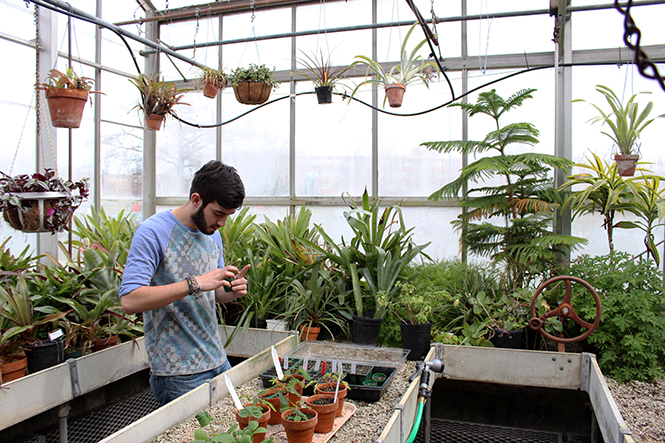Herrick Conservatory seeks outreach for community education
April 7, 2014
Walking into the Herrick Conservatory, there is an overwhelming amount of stimulation to the senses. The bright colors of the tropical flowers and leaves and the feeling of the warm, humid air make its visitors feel as if they have been put right into a tropical rainforest.
The Kent State greenhouse, which is home to many plants from around the world, is vivid and exotic. However, most students do not know that the greenhouse is there and open to the public.
Melissa Davis, horticulture facilities director, was recently hired after the former director, Christopher Rizzo, retired after a 37-year-long dedication to the department. Davis said big changes are coming to the greenhouse in order to gain more outreach.
“With new hands comes a new set of eyes,” Davis said. “One of the things we had to do is assess the condition of the greenhouse and in any growing situation, you have to stay with the times. Things need updated, and if you don’t do that things can fall in disrepair.”
Davis said that the greenhouse is “very aesthetically pleasing, but it also serves a purpose.” Andrea Case, is an associate professor of biological sciences and hopes to expand the educational and research opportunities in the greenhouse.
“I’m hoping to develop a plant biology lab where we could use the greenhouse,” Case said. “I sometimes bring students in to observe and see the things that we talk about in class, but we aren’t really using it for lab purposes. That is something that we would like to develop and create some space for students to do work.”
Case uses the facility for her own research on sex determination in plants but said that the space could also be utilized for other faculty research.
“We have other faculty members that if there was more space dedicated to research that they could potentially use it for their own projects and for their graduate students,” Case said. “We are hoping to branch out as much as we can with a limited space.”
Davis said that outreach has gone beyond the biology department. She said they will be working with elementary schools and doing more interdisciplinary work with other departments in the near future.
“Recently, we had art students come in and draw the plants,” Davis said. “For them, it’s important to have a variety of things to draw and in [the greenhouse] there are so many shapes, colors and textures.”
Brandon Ashcraft, sophomore botany major, works in the greenhouse assisting Davis and taking care of the plants. He said there is a lot to offer in the greenhouse for anyone who takes the time to walk around.
“Not a lot of people know that we are here and open to the public, and we have such an enormous selection of plants,” Ashcraft said. “People are more interested in it once they actually see it, so we just want more people to come and see everything we have.”
Ashcraft pointed out the art students as an example of the different ways the greenhouse can be utilized.
“You can go outside in the rain and draw a bush, or you can come in the green house where it’s 70 degrees all the time and never rains,” Ashcraft said. “You can also draw a plant that is never going to change. It’s not going to get eaten up by bugs or die. They can sit here and draw a plant perfectly without any outside interference.”
Biology Department interim Chairsperson Laura Leff said that she hopes increasing public relations and outreach for the greenhouse will provide more opportunities for student research.
“There is certainly a physical transformation of the departments, but there are also going to be changes in how students learn and interact with faculty and research,” Leff said. “In the future, I hope that we can introduce more interdisciplinary research and courses for students to participate in. Then students could work with professors in different departments that they usually wouldn’t work with and over time increase those connections.”
Leff said that the greenhouse is not just a place for education and research but also a place to admire the beauty of the plants.
“We want people to take advantage of our facility, not just in a research or educational way, but maybe just to take a break, especially in those winter months,” Leff said.
The conservatory also assists the biology club in its yearly plant sale fundraiser potentially set for late April.
Contact Haley Baker at [email protected].












